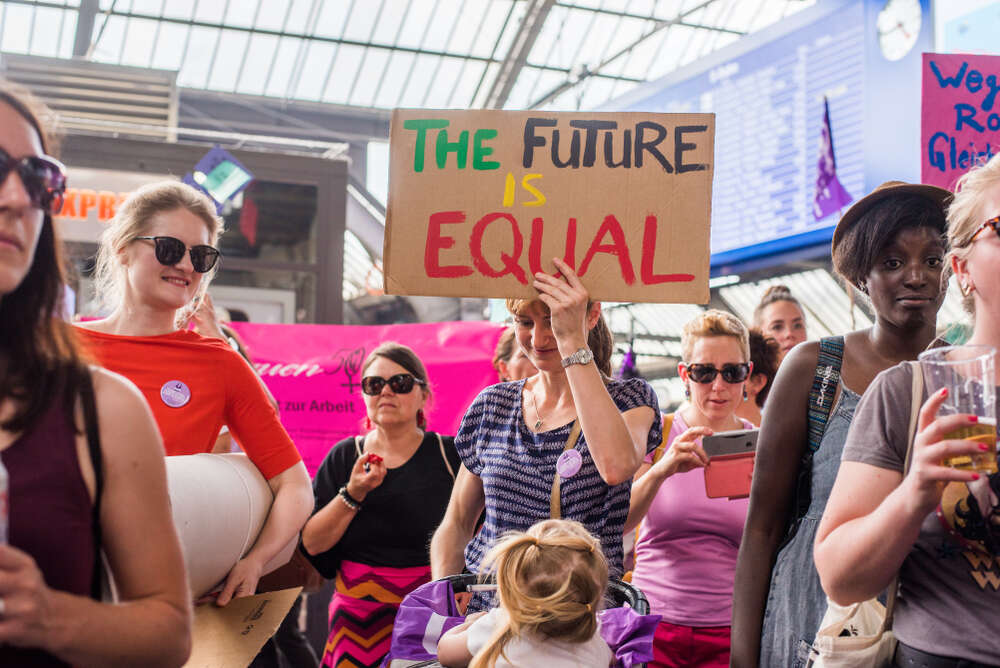
The gender gap persists among scientists and engineers in Europe despite steady progress in the last decade.
Official figures from Eurostat show that 41%, or 6.3 million, of scientists and engineers between the ages of 25 and 64 across the EU are women. In 2008, the earliest date figures are available, the percentage was 32%.
The representation of women in these jobs varies from sector to sector. Whereas female engineers and scientists are still largely under-represented in manufacturing (21%), they achieve better quotas in the services sector (46%).
Of the 36 countries examined in the statistics, which include non-EU states such as Norway, Switzerland and Turkey, only six had 50% or greater of scientists and engineers who are female.
In the EU bloc there are 229 million women – 51% of the total population – across its 28 member states (figures are from 2019 and include the UK). The numbers do not explicitly account for womxn and non-binary people, nor it presents intersectional data that could address the multiple dimensions of identity and social systems relating to inequality.
Today, 11 February, is International Day of Women and Girls in Science. This year, the UN is celebrating the critical role that women scientists are playing in the different stages of the fight against Covid-19.
Top performers
For the first time since the recording of statistics began, Norway ranks at the top with 55% of scientists and engineers who are female. It is followed by Lithuania (54%), which until 2019 had been in the leading position, reaching 61% for two consecutive years at the beginning of the last decade. However, there has been a steady decline since 2013, and despite women being more visible in traditionally male-dominated fields, experts claim that Lithuania still has not seen a major breakthrough in gender equality.
The feminist movement began early in Lithuania, and the country was one of the first in the world to abolish the ban on abortion in 1955 and during communism emancipatory policies were implemented. However, since its independence from the Soviet Union in 1990, conservative attitudes towards women and patriarchal values have been on the rise as a reaction to the old Soviet regime.
Åshild Hanne Larsen, chief information officer (CIO) and SVP IT at Norwegian energy company Equinor, believes that one of the reasons for Norway having a good proportion of women in science and engineering is the presence of strong female role models in politics, academia and the private sector. She said: “Remember, if you can’t see it, you can’t be it.”
Larsen, a keynote speaker at New Statesman Media Group’s Virtual CIO Symposium in November 2020, adds that her country has more than ten years of experience with quotas for women board members, and she is certain that this has also contributed to a change in the attitude and political debate regarding gender balance. However, as a CIO she sees that lack of diversity is still persistent in IT.
“To me this is an important challenge to address, especially as IT becomes more and more fundamental to the way we work and interact,” Larsen tells Tech Monitor. “The people who choose a career within IT are the ones who get to shape what products and services we will have access to in the future. And to make these solutions innovative and ensure they address different needs, the teams who design and develop them must also be diverse.”
Elsewhere in the Nordics, Denmark has seen the biggest change. While women made up 30% of scientists and engineers in 2008, by 2019 the figure had increased to 52%.
What happened to Luxembourg and Finland?
A notable underperformer is Luxembourg, the only country in Europe not achieving at least 30% of female representation among scientists and engineers in 2019, considerably below the EU average of 41%. Currently at 28%, Luxembourg has improved only six percentage points since 2008.
To address this situation, the Luxembourg National Research Fund (FNR) has implemented a number of measures, including having more women at top executive levels of the FNR’s governing board and scientific council. However, the UN Committee on the Elimination of Discrimination against Women criticised the Luxembourg Ministry of Equal Opportunities gender-neutral practice approach for not giving sufficient priority to the advancement of women to achieve equal rights. It also highlighted the lack of a strategic framework able to address multiple and intersecting forms of discrimination, including gender mainstreaming and gender-responsive budgeting.
The second-worst performer is Finland at 31%, which since 2008 has improved by six percentage points. Unlike its Nordic neighbours, Finland has been falling behind the EU average of women in science and engineering. The results from the last decade go through peaks, dipping in 2014 and gradually going up again in the following years.
Similarly to Norway, Iceland or Sweden, the country is perceived as a model for gender equality and by 2018, it had closed 82% of its overall gender gap, according to World Economic Forum figures. However, the country also recorded a widening gender gap on economic participation and opportunity, which the WEF attributed to a decreasing share of women among legislators, senior officials and managers. And despite this, Finland was in 2018 the only Nordic country with a fully closed gender gap on educational attainment.
So why is the country still having such a poor representation of women in science and engineering?
A possible explanation could be what is been dubbed the “gender equality paradox”, where countries with greater gender equality perform worst at female STEM participation than countries with lower gender equality. Based on research by two UK and US universities, the study found that countries with greater gender equality see a smaller proportion of women taking degrees in STEM.
According to this narrative, broader economic factors appear to cause lower participation of women in STEM subjects. The logic behind it is that when women have to worry less about economic concerns, as is the case in countries with greater gender equality, “sex differences in academic strengths and occupational interests more strongly influence college and career choices”, the study claims.
Others, however, think that social conditioning and patriarchal structures are the real reasons preventing Finnish women having a fair representation in scientific and engineering roles. After all, the “gender equality paradox” does not apply to Norway, Sweden or Iceland.
Poland, Ireland and Belgium, despite performing above the EU average, have fewer women in science and engineering than they did in 2008. In the case of Poland and Ireland, which at some point reached 54% and 52%, respectively, both have dipped to 48%.
Poland, which was among the first nations where women achieved the legal right to vote in 1918, is witnessing a setback on women’s rights under the Law and Justice party.
Expect bad news?
Despite the slow progress made over the past 12 years, the majority of European countries still have not achieved the 50% mark for women in science and engineering roles yet. Although 2020 figures are not yet available, we will likely see a slight decrease due to the pandemic, says Merici Vinton, co-founder and CEO at Ada’s List, a global community for women and non-binary people in tech.
“As we know, [Covid-19] has put many women at a disadvantage in their careers, with increased care responsibilities in the home,” she adds. “Unemployment must be a massive contributing factor to these low rates.”
Vinton has seen this reflected in the Ada’s List community, with many more members speaking out about being out of work and looking for their next job. The network is now helping jobseekers and partnering with companies who are looking to hire more women in technology.
“Over the past six months, we’ve shared almost 80 engineering roles with our community, with locations all over the world – from London to San Francisco to Luxembourg, to Paris, and beyond,” says Vinton. “There are engineering roles out there and plenty of talented women to fill the roles, now we need these employers to put in the work to attract, recruit, hire, and retain women into these roles.”
Home page photo by Elizabeth Dalessandro/Shutterstock.






